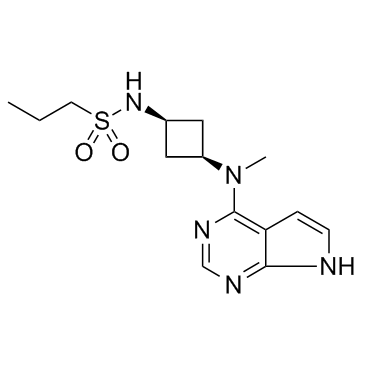Abrocitinib (PF-04965842) (Synonyms: PF-04965842) |
| Catalog No.GC32023 |
아브로시티닙(PF-04965842)(PF-04965842)은 강력한 경구 활성 및 선택적 JAK1 억제제이며 JAK1 및 JAK2에 대해 각각 IC50이 29 및 803nM입니다.
Products are for research use only. Not for human use. We do not sell to patients.

Cas No.: 1622902-68-4
Sample solution is provided at 25 µL, 10mM.
Abrocitinib (PF-04965842) is a potent, oral active and selective JAK1 inhibitor, with IC50s of 29 and 803 nM for JAK1 and JAK2, respectively. Abrocitinib (PF-04965842) exhibits less active effect on TYK2 (IC50, 1.253 μM), and inhibits phosphorylation of STAT1,STAT3 and STAT5 after stimulation. Effective in autoimmune disease[1].
Abrocitinib (Compound 25) inhibits IFNα-stimulated phosphorylation of STAT3, IFN-stimulated phosphorylation of STAT1 in human whole blood (HWB), as well as pSTAT5 in CD34+ spiked into HWB (JAK2), with IC50s of 189, 163 nM, 7.178 μM, respectively[1].
[1]. Vazquez ML, et al. Identification of N-{cis-3-[Methyl(7H-pyrrolo[2,3-d]pyrimidin-4-yl)amino]cyclobutyl}propane-1-sulfonamide (PF-04965842): A Selective JAK1 Clinical Candidate for the Treatment of Autoimmune Diseases. J Med Chem. 2018 Feb 8;61(3):1130-1152.
Average Rating: 5 (Based on Reviews and 25 reference(s) in Google Scholar.)
GLPBIO products are for RESEARCH USE ONLY. Please make sure your review or question is research based.
Required fields are marked with *




















